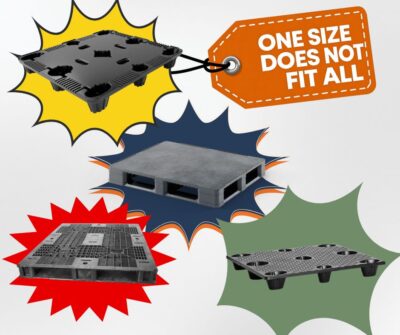Pallets are the backbone of modern logistics and supply chain management. Whether you’re shipping consumer goods, industrial components, or fresh produce, the choice between plastic pallets and wood
pallets can significantly impact your bottom line and operational efficiency. Below is the breakdown of the
pros and cons of each pallet type so you can make an informed decision.
COST & TOTAL COST OF OWNERSHIP
Wood Pallets
- Upfront Cost: Typically lower, making them a budget-friendly choice for businesses needing large quantities.
- Ongoing Costs: Wood pallets can break or splinter over time, requiring repairs or replacements.
- Repairability: Wood pallets can be fixed relatively easily – damaged boards or stringers can be replaced.
Plastic Pallets
- Upfront Cost: Higher initial cost compared to wood pallets.
- Long-Term Savings: Plastic pallets usually last much longer (sometimes up to 10 times longer),
reducing the frequency of replacements. This can offset the higher purchase price over time. - Repairability: While some minor damage can be patched, extensive damage often means
replacement. However, the need for repairs is generally less frequent.
Key Takeaway: If your operations are short-term or if you lose a lot of pallets in transit, wood
pallets might seem more economical. However, if you’re looking at long-term cost savings and
durability, plastic pallets can be more cost-effective over time.
DURABILITY & STRENGTH
Wood Pallets
- Pros: Robust and can carry heavy loads, depending on the quality and thickness of the boards.
- Cons: Prone to splintering, rot, and pest infestation if not stored properly. Frequent handling or harsh conditions can shorten their lifespan.
Plastic Pallets
- Pros: Generally resistant to moisture, chemical absorption, and pests. They don’t splinter, making them safer for both workers and products.
- Cons: Extreme cold or high-impact dropping can occasionally cause breaking in lower-quality plastic pallets. Higher-grade plastics (like HDPE or PP) are more resistant to such issues.
Key Takeaway: In terms of lifespan, plastic pallets outshine wood pallets. Wood pallets perform
well but can degrade more quickly, especially in wet or harsh environments.
HYGIENE & CLEANLINESS
Wood Pallets
- Surface: Porous and can retain moisture, making them a potential breeding ground for bacteria, fungi or pests.
- Maintenance: Requires regular inspection, especially for industries with strict hygiene standards (food, pharmaceuticals). Thorough cleaning can be challenging.
Plastic Pallets
- Surface: Non-porous, easy to clean and sanitize. Resistant to moisture and less likely to harbor bacteria.
- Compliance: Often meets higher sanitation requirements, making them ideal for food & beverage, pharma, and other clean-sensitive operations.
Key Takeaway: Plastic pallets are typically preferred where strict hygiene is a priority. If your
products demand a high level of cleanliness, the ease of washing and sanitizing plastic pallets can be
a major advantage.
WEIGHT & HANDLING
Wood Pallets
- Weight: A standard 48” x 40” wood pallet can weigh 30-50 pounds or more, depending on the wood quality and moisture content.
- Handling Implications: Heavier pallets can increase shipping costs. On the other hand, wood pallets can be more stable when stacking due to their rigid structure.
Plastic Pallets
- Weight: Often lighter, in the range of 15-30 pounds, depending on the design and material
- Handing Implications: Lighter weight can lower shipping costs and may reduce strain on workers, though the actual numbers will depend on pallet type and load requirements.
Key Takeaway: Plastic pallets often reduce shipping costs due to their lighter weight. However, not
all plastic pallets are lighter. Some heavy-duty or reinforced plastic pallets can weigh as much as or
more than a wooden counterpart.
ENVIRONMENTAL IMPACT
Wood Pallets
- Renewable Resource: Made from wood, a natural and renewable material.
- Recyclability: Broken boards can be turned into mulch or reclaimed for other wood products.
- Waste: Though wood is biodegradable, poorly maintained or low-quality pallets can lead to frequent disposal.
Plastic Pallets
- Longer Lifespan: Required fewer replacements, reducing overall waste.
- Recyclability: Many are made from High-Density Polyethylene (HDPE) or Polypropylene (PP), both of which can be recycled into new pallets or tother plastic products.
- Carbon Footprint: Lighter shipping weight can result in lower transportation emissions. However, producing plastic has its own environmental considerations.
Key Takeaway: Wood is a naturally renewable resource, but plastic pallets often have a longer life
and are recyclable. The net environmental impact can vary based on your operational lifespan,
disposal methods, and recycling programs.
COMPLIANCE & EXPORT CONSIDERATIONS
Wood Pallets
- Heat Treatment: Must comply with ISPM-15 regulations (heat-treated or fumigate) toprevent pests during international shipping. This adds extra costs and steps.
- Inspection: Wooden pallets must be checked for stamp markings to confirm compliance.
Plastic Pallets
- No Fumigation: Exempt from ISPM-15 because they aren’t prone to pest infestations.
- Streamlined Exports: No need for additional treatments or documentation for heat-treated compliance.
Key Takeaway: For international shipments, plastic pallets simplify compliance and reduce potential
customs delays.
INDUSTRY & APPLICATION USE CASES
Wood Pallets
Ideal For:
- Heavy duty shipments in domestic markets.
- Industries with lower hygiene requirements.
- Situations where pallets are frequently lost or not returned.
Plastic Pallets
Ideal For:
- Food & Beverage and Pharmaceuticals, where sanitation is paramount.
- Export businesses needing ISPM-15 exemption.
- Companies seeking long-term cost savings and reduced waste.
- Automotive and Electronics, where robust, non-splintering pallets are needed.
WHICH PALLET SHOULD YOU CHOOSE?
Evaluate Your Budget
- Short-term or high turnover on pallets? Wood pallets might be less costly up front.
- Long-term use with closed-loop systems? Plastic pellets can offer a better return on investment.
Assess Handling & Environment
- Harsh, damp or frequently sanitized conditions benefit from plastic pallets’ resilience.
- Moderate handling and dry storage might be enough for wood.
Check Regulatory Requirements
- Food, pharma, or cross-border shipments often favor plastic
- Local domestic operations with fewer restrictions can use wood without extra treatments.
Consider Your Sustainability Goals
- Wood is renewable, but plastic pallets’ longevity and recyclability can minimize waste.
- Collaborate with suppliers offering recycling or buyback programs for either material.
CONCLUSION
When comparing wood pallets to plastic pallets, there are no one-size-fits-all answer. Each type has its
unique advantages and trade-offs:
- Wood pallets are cost-effective, easy to repair, and made from a renewable resource.
- Plastic Pallets offer superior hygiene, durability, and compliance benefits, often leading to long-term cost savings despite a higher initial price.
Ultimately, the best choice depends on your industry, transport requirements, budget, and sustainability
goals. By carefully weighing these factors, you can select the pallet solution that delivers the greatest value
and efficiency for your supply chain.







